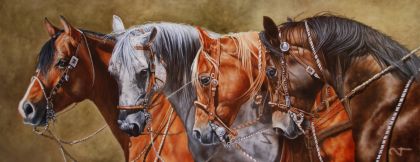Difference between revisions of "Horse (domestic)"
Tao alexis (talk | contribs) |
Tao alexis (talk | contribs) |
||
| Line 36: | Line 36: | ||
|} | |} | ||
| − | '''Domesticated Horses''' are adapted to run, allowing them to quickly escape predators. They possess an excellent sense of balance and a strong fight-or-flight response. Spirited, hot-blooded horses are bred for speed and endurance, finding work as [[Warhorse|warhorses]], [[Horseracing (sage ability)|racehorses]] and for riding and driving. "Cold-bloods" are employed for slow, heavy work, particularly in agriculture and haulage. For these uses, domesticated horses are provided with [[Horse Feeding & Diet (sage ability)|food]], water and shelter, as well as [[Horse Physiology (sage ability)|care]] and shoeing. | + | '''Domesticated Horses''' are adapted to run, allowing them to quickly escape predators. They possess an excellent sense of balance and a strong fight-or-flight response. Spirited, hot-blooded horses are bred for speed and endurance, finding work as [[Warhorse|warhorses]], [[Horseracing (sage ability)|racehorses]] and for riding and driving. "Cold-bloods" are employed for slow, heavy work, particularly in agriculture and haulage. For these uses, domesticated horses are provided with [[Horse Feeding & Diet (sage ability)|food]], water and shelter, as well as [[Horse Physiology (sage ability)|care]] and [[Horseshoeing (sage ability)|shoeing]]. |
| + | [[File:Horse.jpg|left|420px]] | ||
| + | Most horses in the world are purebreds, firstly because there is little transference of breeds between regions. Breeds tend to be known by their place of origin, having distinctive characteristics transmitted consistently to their offspring, such as colour, performance and disposition. Selective [[Horse Breeding (sage ability)|breeding]] is practiced locally, with breeds being developed to serve a particular function. Thus, the height and weight of horses comes from efforts made for hundreds of years to produce specific forms of horse. | ||
| + | == Types == | ||
| + | '''Riding Horses''' are used primarily for transportation and for pleasure. The chief means of travelling long distances for those who possess wealth and status, riding horses are also used for jumping, hunting and racing. They are used for constabulary work, for controlling herd animals and often as a means for a landowner to oversee their estates. Riding horses may be put to work for farming or as cart-horses, but as they tend to be warm or hot-blooded, they do not always have a suitable temperament for this type of work. | ||
| + | '''Draught Horses''' | ||
| − | + | WORKING... | |
| − | |||
| − | |||
See [[Bestiary]] | See [[Bestiary]] | ||
| − | |||
| − | |||
| − | |||
Revision as of 04:13, 7 September 2020
| Type | Riding | Draught | Pony |
| Species | hoofed mammal | ||
| No. Appearing | 1 | 1 | 1 |
| Behaviour | domesticated | ||
| Range | rural, urban | ||
| Size at the withers |
14-16 hands | 15-17 hands | 14 hands |
| Weight | 1,000-1,300 lbs. | 1,000-1,500 lbs. | 600-800 lbs. |
| Intelligence | 2 | 2 | 2 |
| Armour Class | 7 | 7 | 7 |
| Hit Dice | 2 | 3 | 1 |
| Action Points | 6 | 5 | 5 |
| Max. Stride | 17 | 12 | 14 |
| THAC0 | 20 | 19 | 20 |
| Hp/Die | d4+d6 | d4+d6 or d12 |
d106 |
| Attack Form | bite | ||
| Damage | 1-3 | 1-3 | 1-2 |
| Special Attack | back kick | none | |
Domesticated Horses are adapted to run, allowing them to quickly escape predators. They possess an excellent sense of balance and a strong fight-or-flight response. Spirited, hot-blooded horses are bred for speed and endurance, finding work as warhorses, racehorses and for riding and driving. "Cold-bloods" are employed for slow, heavy work, particularly in agriculture and haulage. For these uses, domesticated horses are provided with food, water and shelter, as well as care and shoeing.
Most horses in the world are purebreds, firstly because there is little transference of breeds between regions. Breeds tend to be known by their place of origin, having distinctive characteristics transmitted consistently to their offspring, such as colour, performance and disposition. Selective breeding is practiced locally, with breeds being developed to serve a particular function. Thus, the height and weight of horses comes from efforts made for hundreds of years to produce specific forms of horse.
Types
Riding Horses are used primarily for transportation and for pleasure. The chief means of travelling long distances for those who possess wealth and status, riding horses are also used for jumping, hunting and racing. They are used for constabulary work, for controlling herd animals and often as a means for a landowner to oversee their estates. Riding horses may be put to work for farming or as cart-horses, but as they tend to be warm or hot-blooded, they do not always have a suitable temperament for this type of work.
Draught Horses
WORKING...
See Bestiary
